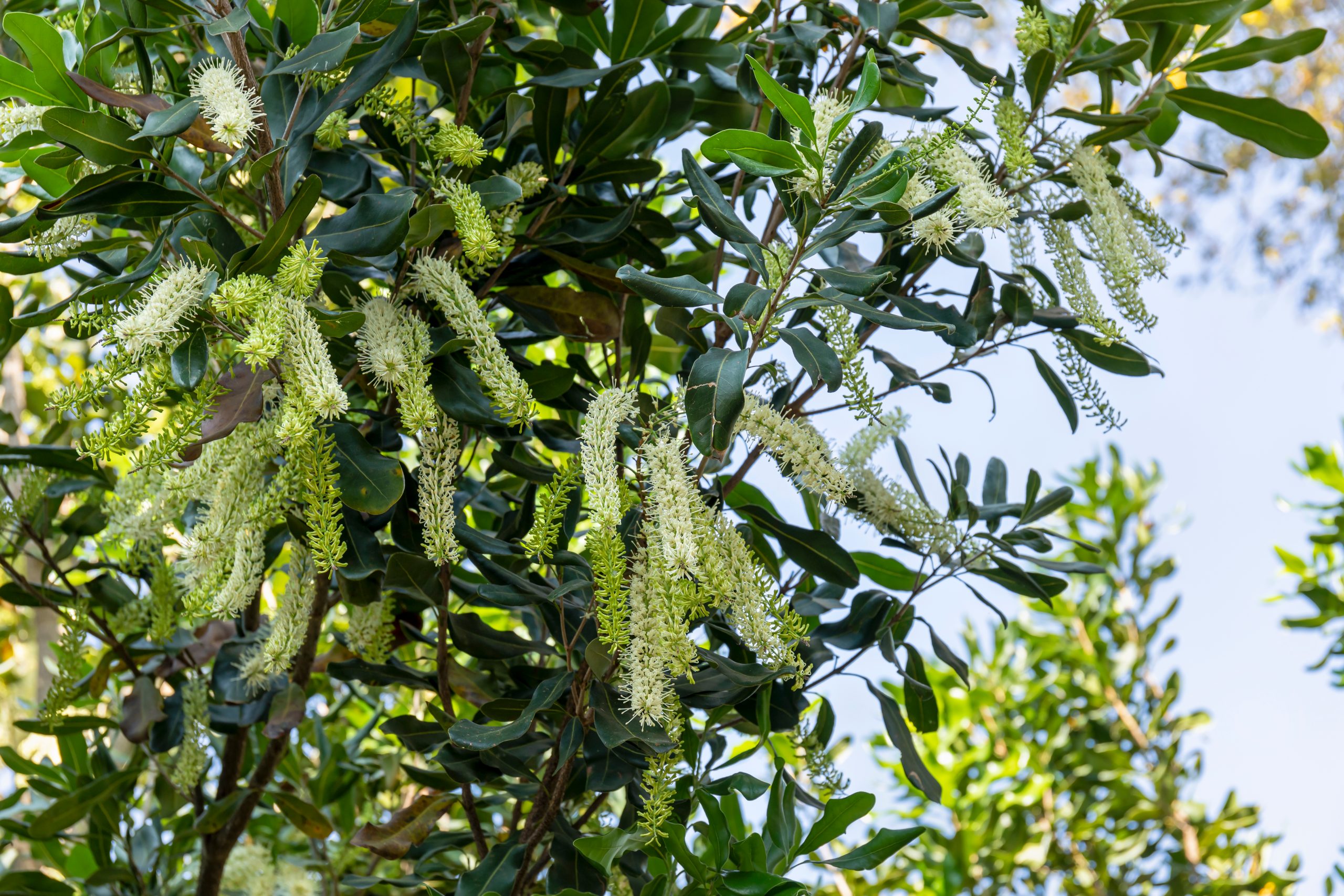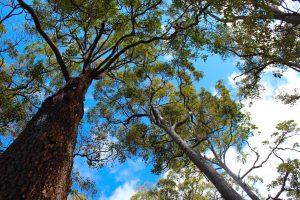
Macadamia honey is a monofloral variety produced from honey bees harvesting the nectar and pollen of the white flowers that blossom on the macadamia trees. The honey’s taste, colour and aroma varies considerably depending on its origins.
Macadamia honey that is produced in Hawaii tends to have a much higher concentration of macadamia pollen and nectar than macadamia honey produced in Australia. In Hawaii, bees are placed near orchards and allowed to focus exclusively on macadamia food sources. In Australia, honey bees tend to supplement a diet of macadamia with flowers from other sources to make up for the fact that the protein levels in macadamia pollen can vary from 16% to 22%.
As a result, Hawaiian macadamia honey is light in colour, nutty in flavour, and floral in aroma. Australian macadamia honey, in comparison, tends to be more like molasses in flavour and colour.
Where Does Macadamia Honey Come From?
Commercial orchards and wild growths of macadamia trees are common in Australia and in the U.S. state of Hawaii.
Hawaii is the world’s largest producer of macadamia honey and among the largest producers of macadamia nuts globally.
Australia as of 2019 has 800 growers, producing 46,000 tons of macadamia nuts (3.5% moisture, 49,000 tons at 10%) of which 70% are exported and by 2025 they’re forecasting a 70,000 tons production (3.5% moisture, 75,000 tons at 10% moisture).

By having such a large macadamia nut production, they’ve become the 2nd largest producer of macadamia honey. Countries throughout Asia, Africa, Central, and South America have recently begun to emerge as significant contributors to the total of the world’s production of macadamia honey.
Interestingly, in 2019, researchers collected samples from macadamia orchards in Queensland, Australia and those found in Hawaii. They determined that all the Hawaiian macadamia trees must have descended from a small population of Australian trees from a small Queensland town; Gympie, and it could have been just a single tree.
They estimate 70% of the world’s macadamia nuts origins can be traced to the small Queensland town of Gympie.
How Is Macadamia Honey Produced?
Honey bees harvest the nectar and pollen from the flowers that blossom on the trees that produce macadamia nuts.
Macadamia honey producers will position apiaries deep inside macadamia tree orchards to ensure honey remains monofloral.
The moment the honey bee collects the macadamia blossom nectar, it is mixed with an enzyme within the bees mouth.

The enzyme itself is known as invertase or the “bee enzyme” which is secreted from the bee’s glands. When the honey bees return to the hive, they will pass the macadamia nectar they have collected between themselves further mixing the nectar with the “bee enzyme”.
This will reduce the water content converting the nectar into honey. They will then deposit the macadamia honey into wax cells, but at this point, the water content may be too high. To reduce the water content, the honey bees will fan their wings above the wax cell, this, in turn, will evaporate some of the water.
Once they’ve finished the process, the dandelion honey will have a water content roughly below 20%. It will then be capped, and the honey bees will repeat the process all over again.
It’s worth noting, everywhere that macadamia nuts are cultivated and grown for commercial farming purposes, honey bees play an essential role by pollinating those blossoms to make sure that trees yield abundant amounts of macadamia nuts.
The farmers and beekeepers who oversee this process gather the honey that the bees produce to generate an additional revenue stream. Due to the increasing popularity and recently discovered health benefits, many other countries have begun to farm macadamia nuts. These include Brazil, China and Fiji.
Producing macadamia honey is considered a lucrative side business to the farming of macadamia nuts.
The Best Environment for Producing Macadamia Honey
Macadamia trees thrive in tropical and sub-tropical environments.
That is why they are so common in countries like Australia, Fiji, Brazil, and China as well as the U.S. state of Hawaii.
The rising popularity of macadamia nuts means that countries all over Asia, Africa, and Central and South America are beginning to cultivate macadamia orchards.

Orchards that are set up using the most advanced agricultural methods available today provide the best environments for producing macadamia honey. Modern macadamia orchards use scientific methods to ensure the greatest yield per acre in macadamia nuts.
One study tested a new honey gathering system “Flow Frame” which was crowdfunded back in 2015 and is argued to be the most significant development in beekeeping since 1852.
The study utilised the flow frame within macadamia honey production, and they found using the Flow Frame system had higher floral and cleaner aftertaste sensory scores than the honey extracted using commercial methods that involve the use of heat and centrifugation.
Furthermore, as macadamia nut production increases worldwide, so does the macadamia honey production, but why? Well, a study by the University of Hawaii, Honolulu found Honey bees placed in commercial apiaries in a macadamia orchard increased the nut yields of 2 out of 3 cultivars tested.
Thus many macadamia nut farmers are using apiaries to pollinate their macadamia crop, with the byproduct being macadamia honey.

Benefits of Macadamia Honey?
| Healing Wounds and Burns | There has been positive effects of using raw honey on wounds & burns reported. |
|---|---|
| Reducing The Duration of Diarrhoea | According the NCBI consumption of raw honey has been shown to reduce the severity & duration of diarrhoea. |
| Preventing Acid Reflux | Research has shown that with honey lining the oesophagus and stomach, it actually can reduce the upward flow of undigested food and stomach acid. |
| Fighting Infections | Scientists in 2010 reported that honey through its protein (defensin-1) has the ability to kill bacteria. |
| Relieving cold and cough symptoms | Its been proven that honey may prove beneficial in relieving cold and cough symptoms. The World Health Organisation actually recommend honey as a natural cough remedy. |
| Rich In Antioxidants | High quality raw honey contains many helpful antioxidants. These include phenolic compounds like flavonoids and organic acids. |
| Can Lower Triglycerides | Triglycerides are associated with insulin resistance and are a major driver of type 2 diabetes. Multiple studies have linked regular honey consumption with lower triglyceride levels, especially when it is used to replace sugar. |
This is based on raw honey. Filtered or pasteurised honey will break down and diminish these benefits.
Macadamia Honey as an Antiseptic
Many people like to use honey as a topical healing agent, and Macadamia honey is no exception! Macadamia honey is an excellent antiseptic which helps to dry out wounds, aiding in the hindrance of growth of fungi and bacteria.
Macadamia Honey vs Regular Honey
Macadamia honey is most commonly sold in its raw form. That means that it retains the bee pollen, propolis, and other beneficial compounds that are typically removed by fine filtering or destroyed by pasteurisation during the processing that regular honey goes through.
In a raw state, macadamia honey will naturally contain many if not all of the benefits listed above. Hawaiian macadamia honey is light in colour, nutty in flavour, and floral in aroma. Whilst Australian macadamia honey tends to be more like molasses in flavour and colour.
In comparison, regular honey will hold that somewhat industrial standard taste and tends to be missing crucial benefits and nutritional properties of raw honey. This is typically due to “regular” mass-produced honey being fine filtered and pasteurised which, unfortunately, destroys many of the antibacterial and active elements.
Research shows that the processing of honey can reduce antioxidant levels by up to (and even more than) 30%. The reduction of these antioxidant reduces macadamia honey’s effectiveness as an antibacterial and antimicrobial agent.

When Should You Avoid Macadamia Honey?
You should avoid macadamia honey if you have any allergies that may make you sensitive to either honey or macadamia nuts. If you have an allergy to bees and you are unsure if you will react to honey, you should consult with your doctor.
Furthermore, raw honey of any kind, including macadamia honey, should never be given to a child under a year old. This is because raw honey can cause a rare but serious disease (Infant Botulism) caused by a specific type of bacteria.
When children are a year old or older, they usually have more robust immune systems, and the risk of eating raw honey is reduced.
Is Macadamia Honey Vegan?
The Vegan Society do not consider honey vegan, this includes cornflower honey. They believe that because some honey farmers replace honey with a sugar substitute when harvesting, it will naturally lack the essential micronutrients of honey, thus being detrimental to the honey bees.
Furthermore, they believe that in conventional beekeeping, honey bees are specifically bred to increase productivity. Which they believe leads to a narrowing of the population gene pool and increases susceptibility to disease and large scale die-offs.
They also believe that many honey farmers will cull their hives post-harvest and clip the queen bee’s wings to stop them from leaving to start a new colony. Thus the Vegan Society does not consider honey vegan. That, of course, doesn’t stop some vegans arguing its fine if they source their honey from reliable sources that do not practice the above.

What Is Macadamia Honey Used For?
Macadamia honey is used in all of the ways that people use other monofloral varieties. It is popular as a topping for bread and dairy products when you want something sweet. This can range from oatmeal to pancakes and waffles through ice cream or yoghurt.
Macadamia honey is also popular as a sweetener for beverages like tea and coffee. There are many ways to use macadamia honey as a dietary supplement or home remedy. This can range from taking a spoonful of raw honey to boost immunity to using honey to treat a wound or a burn.
One other way that macadamia honey is used is as a feedstock for macadamia nut honey wine. It is a popular dessert wine that sustains much of the sweetness and flavour that you find in the raw honey.
Is Macadamia Honey Expensive?
Macadamia honey prices vary widely according to the region of origin and level of purity. In the United Kingdom, it can be found for £15 – £20 per 100g and the United States $10 to $30 per 100g.
As previously mentioned, this can vary wildly depending on your location and the purity you’re looking for.
Sources
Medical News Today | Healthline | NCBI | CAB Direct | Science Direct | Research Gate








